ความเชื่อถือได้ในการประเมินซ้ำและความสอดคล้องภายในเนื้อหาของแบบสอบถามคุณภาพชีวิต ของเด็กซีพี (ภาษาไทย)
Main Article Content
บทคัดย่อ
ซีพีเป็นกลุ่มอาการที่มีความผิดปกติของการควบคุมการเคลื่อนไหวและการทรงท่าในประเทศที่พัฒนาแล้ว อุบัติการณ์ของภาวะนี้เท่ากับ 2-2.5ต่อทารกแรกเกิดหนึ่งพันคน การประเมินคุณภาพชีวิตเป็นส่วนหนึ่งของการวัดระดับสุขภาพของเด็ก แบบสอบถามคุณภาพชีวิตของเด็กซีพีถูกพัฒนาขึ้นเพื่อวัดระดับคุณภาพชีวิตของเด็กซีพีโดยเฉพาะและแบบสอบถามนี้ยังไม่ได้รับการแปลเป็นภาษาไทยอย่างเป็นทางการและสมควรศึกษาความเชื่อถือได้ของแบบสอบถาม วัตถุประสงค์ของการศึกษานี้เพื่อแปลแบบสอบถามคุณภาพชีวิตของเด็กซีพีเป็นภาษาไทย และตรวจสอบค่าความเชื่อถือได้ในการประเมินซ้ำและความสอดคล้องภายในเนื้อหาของแบบสอบถามคุณภาพชีวิตของเด็กซีพีฉบับภาษาไทย ผู้เขียนได้แปลแบบสอบถามนี้ตามคำแนะนำในการแปลของผู้พัฒนาแบบสอบถาม แบบสอบถามสำหรับผู้ดูแลหลักเป็นแบบสอบถามสำหรับผู้ที่ดูแลหลักของเด็กซีพีอายุ 4-12 ปี (66 หัวข้อ) แบบสอบถามสำหรับรายงานด้วยตนเองเป็นแบบสอบถามสำหรับเด็กซีพีอายุ 9-12 ปี(52 หัวข้อ) เพื่อศึกษาความเชื่อถือได้ในการประเมินซ้ำและความสอดคล้องภายในเนื้อหาของแบบสอบถามคุณภาพชีวิตของเด็กซีพีฉบับภาษาไทย ผู้ดูแลหลักจำนวน -30 คน และเด็กซีพีจำนวน 30 คนตอบแบบสอบถาม จากนั้นตอบแบบสอบถามซ้ำอีกภายใน 2 สัปดาห์ต่อมา สถิติที่ใช้ในการคำนวณคือ Intraclass correlation coefficient (ICC) เพื่อประเมินค่าความเชื่อถือได้ในการประเมินซ้ำและ Cronbach’s alpha เพื่อประเมินความสอดคล้องภายในเนื้อหาของแบบสอบถามผลการศึกษาพบว่าความเชื่อถือได้ในการประเมินซ้ำและความสอดคล้องภายในเนื้อหาของแบบสอบถามคุณภาพชีวิตของเด็กซีพีฉบับภาษาไทยอยู่ในระดับดีเยี่ยม โดยมีค่าICC มากกว่า 0.7และมีค่า Cronbach’s alpha ระหว่าง0.76 - 0.91
Article Details
เอกสารอ้างอิง
2. Russman B, Ashwal S. Evaluation of children with cerebral palsy. Semin Pediatr Neurol. 2004; 11:47-57.
3. Carr LJ, Reddy SK, Stevens S, Blair E, Love S. Definition and classification of cerebral palsy. Dev Med Child Neurol. 2005; 47: 508-10.
4. Martha WJ, Elaine M, Jean S. Cerebral palsy: Introduction and diagnosis (part I). J Pediar Health Care. 2007; 21:146-52.
5. Michael OS. Cerebral palsy. Semin Perinatol. 2008; 32: 35-41.
6. Thomas MO. Diagnosis, treatment and prevention of cerebral palsy. ClinObstetr& Gyne. 2008; 51:51-60.
7. Else O, Marji ER, Hendrink JS. The epidemiology of cerebral palsy: Incidence, impairments and risk factor. DisabilRehabil. 2006; 28:183-91.
8. Anita M. Outcome assessments in children with cerebral palsy, Part II: discriminatory ability of outcome tools. Dev Med Child Neurol. 2007;49:181-6.
9. Yvonne W, Steven M, David JS, Robert MS. Prognosis for ambulation in cerebral palsy: A population-based study. Pediatrics. 2008; 114:164-71.
10. Heather ODae. Self-reported quality of life of 8-12-year-old children with cerebral palsy. Lancet. 2007; 369: 2171-8.
11. World Health Organization. International classification of functional, disability and health. Geneva: World Health Organization, 2001.
12. World Health Organization. International classification of functioning, disability and health version for children and youth. Genrva: Wold Health Organization, 2007.
13. Jilda VA. Health-relate quality of life in childhood cerebral palsy. Arch Phys Med Rehabil. 2005; 86: 940-5.
14. Liu WY, Hou YJ, Wong AM, Lin PS, Lin YH, Chen CL. Relationships between gross motor functions and health-related quality of life of Taiwanese children with cerebral palsy. Am J Phys Med Rehabil. 2009; 88: 473-83.
15. White-Koning M, Grandjean H, Colver A, Arnaud C. Parent and professional reports of the quality of life of children with cerebral palsy and associated intellectual impairment. Dev Med Child Neurol. 2008; 50: 618-24.
16. Dickinson H, Parkinson K, McManus V, et al. Assessment of data quality in a multi-centre cross-sectional study of participation and quality of life of children with cerebral palsy. BMC Public Health. 2006; 6: 273.
17. Davis E, Waters E, Mackinnon A, Reddihough D, Boyd R, Graham HK. Quality of life of children with CP: condition-specific instrument and proxy reports. Dev Med Child Neurol. 2008; 50:167.
18. Sriseub P. Quality of life of cerebral palsy children (thesis): Chiangmai University; 2000.
19. Somporn Ae. Impact of family who have cerebral palsy children (thesis): Khonkan University; 2007.
20. Tantilipikorn P, Watter P, Prasertsukdee S. Feasibility, reliability, and validity of the Thai version of Pediatric Quality of Life inventory 3.0 cerebral palsy module. Qual Life Res. 2013; 22: 415-21.
21. Liabsirinon S, Tantilipikorn P, MahasupN. Interrater reliability of Thai version of Gross Motor Function Classification System (GMFCS) in Thai children with cerebral palsy. Thai J Phys Ther. 2551; 30: 26-36.
22. Portney LG & Watkins MP. Foundations of clinical research: Application to practice. 3rd ed Upper Saddle River: Pearson Prentice Hall, 2009.
23. Wang HY, Cheng CC, Hung JW, Ju YH, Lin JH &Lo SK. Validating the cerebral palsy quality of life for children (CP QOL-Child) questionnaire for use in Chinese populations. Neuropsychol Rehabil. 2011; 20: 883-98.
24. Morris C, Kurinczuk JJ, Fitzpatrick R. Child or family assessed measures of activity performance and participation for children with cerebral palsy: a structured review. Child Care Health Dev. 2005; 31: 397-407.


